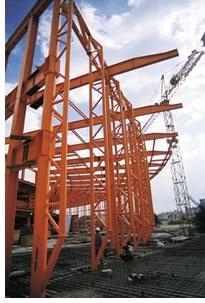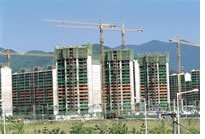

11/2004
by William Baum, director, AIA Allied Groups
 Billions
of dollars worth of construction were represented in one room at the
eighth annual ENR Construction Summit in New York City, October 29. Leaders
of some of the largest building organizations in the world came together
to discuss the construction industry from their point of view. Although
focused mainly on the actual construction of large-scale buildings, much
of the knowledge gained could be applied by architects working on buildings
of any size with clients at every level of sophistication.
Billions
of dollars worth of construction were represented in one room at the
eighth annual ENR Construction Summit in New York City, October 29. Leaders
of some of the largest building organizations in the world came together
to discuss the construction industry from their point of view. Although
focused mainly on the actual construction of large-scale buildings, much
of the knowledge gained could be applied by architects working on buildings
of any size with clients at every level of sophistication.
“Project Owners as Construction Leaders” opened with a spectacular presentation on the construction challenges and innovative thinking that will see 7 World Trade Center become the first financial-grade LEED-certified building in New York, concurrent with the Freedom Tower rising to its full 1,776 feet and becoming the iconic landmark it has been designed to be. Daniel R. Tishman, chairman and CEO of Tishman Construction Corporation, explained that many innovative sustainable features designed into 7 World Trade Center will subsequently be used in the Freedom Tower. Tishman, representing the lead construction company for the tower, spoke with great pride on the building from the ground up, culminating with the spire that “rises and torques, mimicking the Statue of Liberty.” Tishman then hit on the underlying theme of the summit: change. Throughout the question-and-answer period, he fielded questions about how his company became successful. His answers, summarized succinctly: be able to change process and people.
The summit was designed as an open discussion between the audience and panelists. The first session—“So Much to Change, NO Time!”— brought together private owners from Kaiser Permanente, Walt Disney Imagineering R&D, Pfizer, and Princeton University. As the platitude goes, “change is good, you go first.” The leaders on this panel did. Change in seemingly reactionary organizations of this magnitude would appear to be difficult. Not so, in the case of these four presenters. Corporate giants of this ilk do not strategize by reacting to external forces. Instead, they look to flaws in their internal process, which caused them to fall out of step with marketplace change. Certainly, they are constantly looking for “better, faster, cheaper,” but that is only one element of the change process. Another key motivating factor in this discussion was that they were unsatisfied with traditional design-bid-build delivery, which, the panelists agreed, is more accurately described as design-bid-build-litigate.
 Clients’ internal and external
solutions
Clients’ internal and external
solutions
Avoidance of litigation, the panel agreed, has long been a primary reason
for change and affects two areas of the construction program. The first
is the internal processes. Large companies look at their internal process
and ask: “Why are we doing things this way?” Invariably,
the answer is: “Because we always have.” Once the internal
processes have been scrutinized and streamlined to operate with maximum
efficiency, the second area can be addressed: “How should our
contractors construct the building?” The private corporate owners
on the panel said the most important element to a successful building
project is team collaboration. Among a select group of contractors,
consultants, and architects, close collaboration produces a quality
product on time and on budget without litigation. The caveat, as pointed
out in a later session, is that collaboration has more than one definition “to
work jointly with others or together especially in an intellectual
endeavor” and “to cooperate with or willingly assist an
enemy combatant.” An important question to address in team interaction,
then, is: “In your collaborative relationships, which definition
applies, if not both, and how do you approach solutions accordingly?”
Public-sector clients have similar demands
The third panel of the day could have been an extension of the first. “Public
Projects: Difficult Dynamics” brought together a panel of public-owner
heavy hitters and included the Design-Build Institute of America, Office
of the Architect of the Capitol, New Jersey Schools Construction Authority,
N.Y.C. Department of Environmental Protection, and U.S. Army Corps of
Engineers.
The difficulties speakers came to the table to articulate encompassed the political environment, public opinion and involvement, and funding. Once again, the success and failure of a project was determined by two factors, the client’s internal process and the people on the job. One contract administrator for more than 25 years said that it is clear by looking at the regulations for a construction project that these thick volumes either place blame or give directions on what to do when something goes wrong. He changed his internal process, he said, to operate on the precept that everything goes right, which, strangely enough is innovative thinking for a government contract administrator in charge of a high-profile public project (especially since public policy has not—and likely will not be—changed accordingly).
 Other changes in process in the public sector include delivery systems.
Public owners are embracing alternative forms of delivery, such as design-build.
The Design-Build Institute of America reported that public owners are
doing nearly twice the amount of design-build projects today compared
to five years ago. The other changing process for public owners is the
same as the private owners as they ask: “With whom do we work?” The
fact that Qualifications Based Selection (QBS) is becoming more popular
in the public sector is evidence enough. The project leaders feel working
with a qualified architect or contractor will eliminate many of the problems
inherent in doing things the way they have heretofore and result in “better,
faster, cheaper.”
Other changes in process in the public sector include delivery systems.
Public owners are embracing alternative forms of delivery, such as design-build.
The Design-Build Institute of America reported that public owners are
doing nearly twice the amount of design-build projects today compared
to five years ago. The other changing process for public owners is the
same as the private owners as they ask: “With whom do we work?” The
fact that Qualifications Based Selection (QBS) is becoming more popular
in the public sector is evidence enough. The project leaders feel working
with a qualified architect or contractor will eliminate many of the problems
inherent in doing things the way they have heretofore and result in “better,
faster, cheaper.”
The panelists—private and public—have been able to change successfully their respective internal organizational approaches to construction delivery, they said, almost to a person. The panelists and audience alike recognized that the assembled were trend setters—among the first to recognize and implement this level of change—and therefore will likely be leading the design professions and building industry in a whole new direction. By listening to what issues your clients have and the ways in which they are dealing with their current business model will help any architect change apace in real time rather than be forced to constantly be catching up to a new, unfamiliar, and entirely client- and competitor-derived landscape.
Copyright 2004 The American Institute of Architects.
All rights reserved. Home Page ![]()
![]()
 |
||
|
||